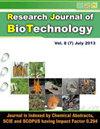Association of leptin gene polymorphism with obesity
IF 0.2
Q4 Biochemistry, Genetics and Molecular Biology
引用次数: 0
Abstract
Obesity is a multifactorial disorder with a high morbidity rate worldwide and is associated with various diseases. Certain mutations in the leptin receptor (LEPR) gene may cause splicing abnormality resulting in a truncated receptor, aberrant signal transduction, leptin resistance, and obesity. A cross-sectional analysis was performed to assess the association of Q223R, K109R, and K656N polymorphisms with obesity and overweight in 293 subjects (obesity n= 136, overweight n=44 and controls = 113) belonging to the rural population of Chennai using PCR-RFLP and in silico analysis. The analysis of Q223R in of leptin gene showed a significant association with obesity and overweight individuals when compared with controls (P<0.05). In obesity, heterozygote genotype showed correlation (OR=0.53, p-value=0.03), demonstrating risk association in the study groups. Also, a significant association was observed in the overweight group having a heterozygous genotype (OR=0.32 p-value=0.005). Analysis of K109R showed no association between obesity and overweight (OR=1.18 in obesity, p-value=.0.368, OR=1.02 p=0.575 in overweight). K656N showed a significant association in overweight individuals (OR=2.34, p-value = 0.0162) and no association with obesity (OR= 2.81, p-value 0.075). The functional impact prediction resulted in typing all the alterations not to be damaging or deleterious, with K656N alone predicted to influence the functioning of the protein. The structural impact prediction showed that all the alterations have a destabilizing effect on the resultant protein. The study showed that Q223R is associated with obesity and overweight. K109R showed no association with obesity and overweight. K656N was significantly associated with overweight but showed no association with obesity. However, scale-up studies from ethnic populations related to more than one risk factor could accomplish obesity pathogenesis.瘦素基因多态性与肥胖的关系
肥胖是一种多因素疾病,在世界范围内发病率很高,与多种疾病有关。瘦素受体(LEPR)基因的某些突变可能导致剪接异常,导致受体截短、信号转导异常、瘦素抵抗和肥胖。采用PCR-RFLP和计算机分析方法,对金奈农村人口293例(肥胖136例,超重44例,对照组113例)的Q223R、K109R和K656N多态性与肥胖和超重的相关性进行了横断面分析。瘦素基因Q223R的分析显示,与对照组相比,肥胖和超重个体存在显著相关性(P<0.05)。在肥胖中,杂合子基因型显示相关(OR=0.53, p值=0.03),表明研究组之间存在风险关联。此外,在基因型为杂合子的超重组中观察到显著的相关性(OR=0.32 p值=0.005)。K109R分析显示肥胖与超重之间无相关性(肥胖OR=1.18, p值= 0.368,超重OR=1.02 p=0.575)。K656N与超重个体有显著相关性(OR=2.34, p值= 0.0162),与肥胖无相关性(OR= 2.81, p值0.075)。功能影响预测结果显示,所有的改变都不是破坏性的或有害的,K656N单独预测会影响蛋白质的功能。结构影响预测表明,所有的改变对合成的蛋白质都有不稳定的影响。研究表明,Q223R与肥胖和超重有关。K109R与肥胖和超重无关。K656N与超重显著相关,但与肥胖无关联。然而,从与一个以上危险因素相关的少数民族人群中进行的大规模研究可以完成肥胖的发病机制。
本文章由计算机程序翻译,如有差异,请以英文原文为准。
求助全文
约1分钟内获得全文
求助全文
来源期刊

Research Journal of Biotechnology
工程技术-生物工程与应用微生物
CiteScore
0.60
自引率
0.00%
发文量
192
审稿时长
1.5 months
期刊介绍:
We invite you to contribute Research Papers / Short Communications / Review Papers:
-In any field of Biotechnology, Biochemistry, Microbiology and Industrial Microbiology, Soil Technology, Agriculture Biotechnology.
-in any field related to Food Biotechnology, Nutrition Biotechnology, Genetic Engineering and Commercial Biotechnology.
-in any field of Biotechnology related to Drugs and Pharmaceutical products for human beings, animals and plants.
-in any field related to Environmental Biotechnolgy, Waste Treatment of Liquids, Soilds and Gases; Sustainability.
-in inter-realted field of Chemical Sciences, Biological Sciences, Environmental Sciences and Life Sciences.
-in any field related to Biotechnological Engineering, Industrial Biotechnology and Instrumentation.
-in any field related to Nano-technology.
-in any field related to Plant Biotechnology.
 求助内容:
求助内容: 应助结果提醒方式:
应助结果提醒方式:


